On May 3 I wrote a review of Nashville Predators forwards from the 2018-19 season. Some of those players, including Ryan Johansen, Viktor Arvidsson, and Rocco Grimaldi, received high grades. Meanwhile, others like Kyle Turris and Calle Järnkrok, didn’t do so well. This article looks at Predators defensemen from this season.
Roman Josi
The Predators’ captain and number one defenseman had another stellar season, with 15 goals and 56 points in 82 games. It was his sixth straight 10-goal, 40-point season and his first time playing in all 82 games. He tied for eighth in scoring among NHL defensemen, his fourth time finishing in the top-10 since 2014-15. He led Predators defensemen and was second on the team in scoring.
Josi’s made a name for himself as a high-risk/high-reward defenseman, and 2018-19 was no different. Among team defensemen at five-on-five, he had the highest break-up and possession exit percentages, the highest zone entries via carry-in and carries via pass percentages, and he was the team’s best player, regardless of position, at entering the offensive zone. On the other hand, he also had the high expected goals against per-60 minutes and highest Corsi against per-60 of Predators defensemen.
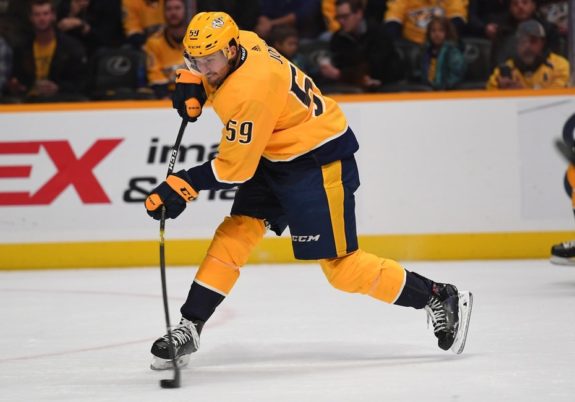
Regardless, he finished with the second-most point shares on the team after Pekka Rinne and remains a high-impact player. Offensively, he increased the team’s threat, both at five-on-five and on the power play. Defensively, however, it was a different story as he negated the team’s impact at five-on-five and on the penalty kill. He’s exciting, dynamic, and has the ability to take over games. He was also one of a handful of Predators who showed up in the playoffs. I haven’t always been Josi’s biggest fan, but in 2018-19 I began appreciating what he brings and his value to the team.
Question(s): With his current contract ($4 million cap hit) expiring after the 2019-20 season, what does his extension, which he can sign on July 1, look like?
Grade: B+ | Josi led the Predators’ blue line and produced in the playoffs, which can’t be said about many of his teammates. He may be turnover prone and makes life difficult on his defense partner, but the positives he brings vastly outweigh the negatives.
Mattias Ekholm
The 2018-19 season was the best of Mattias Ekholm’s career. He set a career high in points (44) and was a plus-27 on the season, tied for 10th-highest in the league. He also led the team in defensive point shares with 6.1, which tied for third-highest in the league. He had great metrics, and even though he set a career high in points, he was at his best when playing in his own zone. Of Predators blueliners, he had the second-lowest Corsi against per-60. On the flip side he allowed a lot of carry-ins, something that was not entirely his fault, but does indicate he was not as solid at defending one-on-one as many may think.
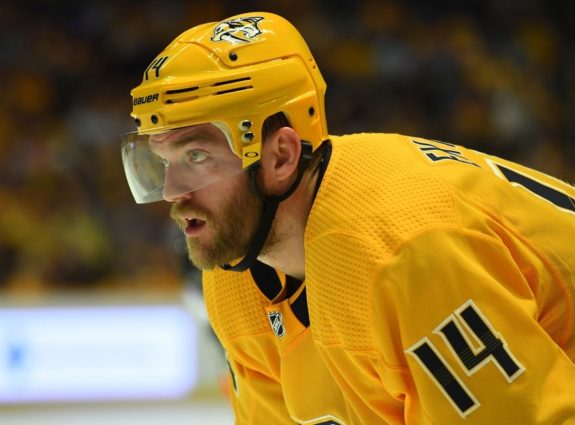
But Ekholm’s biggest issue in 2018-19 was his lack of consistency. During the first half of the season he looked like a Norris Trophy contender, with 41 points in his first 60 games. He imploded from then on, with only three points in his final 20 games of the regular season. It didn’t get any better in the postseason either. He managed two assists in six games, but was a minus-two and only had one takeaway versus seven giveaways. Furthermore, he accumulated 12 penalty minutes when he only had 47 during the regular season.
Question(s): Which version of 2018-19 Ekholm is he? Is he the first-half player who could have been a darkhorse Norris candidate or the one who struggled and cost his team in the playoffs?
Grade: B- | Had Ekholm maintained his first-half pace, he would have received an ‘A.’ Instead, he struggled, both offensively and defensively and it all hit rock bottom in the postseason. He’s a really talented defensemen, and majorly underrated, but his inability to maintain his composure was troubling.
Ryan Ellis
Last August, Ryan Ellis signed an eight-year, $50 million contract extension that has a $6.25 million cap hit. The contract, which kicks in next season, is a big raise over his current $2.5 million cap hit. While his current cap hit was a gross underpay, his new cap hit was puzzling considering he’d never hit the 40-point mark in his career and rode Josi’s coattails the past several seasons. Therefore, entering 2018-19, high expectations surrounded him.
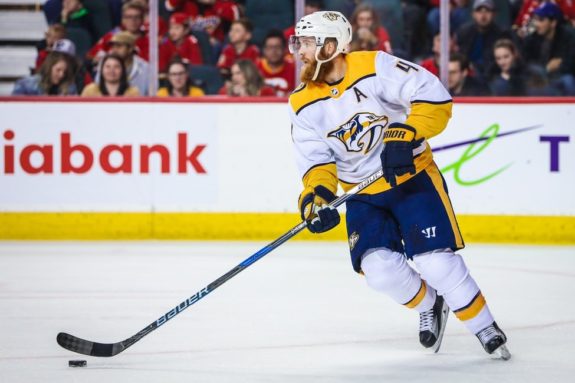
On the surface, Ellis had a good 2018-19 season. He played in all 82 games for the first time in his career and set career highs in points (41), time on ice (24:01), and takeaways (61). He also led Predators defensemen in goals and wins above replacement. Defensively, though, it was a different story. He was below average in break-up and zone exits with possession percentages and had the team’s highest carry-in against and passing plays allowed percentages. Lastly, he doesn’t enter the offensive zone or exit the defensive zone well with possession.
Even from an eye test standpoint, he didn’t look good. In the defensive zone, he often looked out of place and scrambled to regain position. At 5-foot-10, he’s slightly undersized for an NHL defenseman, and even though size isn’t as big a factor as it used to be, Ellis’ lack of physicality, in combination with his stature, can be problematic. Look no further than the series against the Stars in the 2019 Playoffs. In Game 5, with Nashville already down 2-1 in the second period, Ellis was pushed off the puck by Jamie Benn. It resulted in Benn centering a pass to Alexander Radulov who buried the puck for a goal. Nothing Ellis did in that sequence was right, and it ultimately cost the Predators.
Question(s): How does Ellis earn his extension, which starts in 2019-20, when he’s already 28, has a lengthy injury history, and isn’t the most reliable defender? Also, with the Predators likely to move a top-four defenseman this summer, is there a chance Ellis is moved?
Grade: C- | Fresh off signing a lucrative contract extension, Ellis turned in a questionable season. While he did play a full season for the first time in his career, he struggled for much of 2018-19, especially defensively and in the postseason. He had a below average season based off expectations.
P.K. Subban
Judging P.K. Subban’s 2018-19 season is difficult. For starters, he missed 19 games and took awhile to look comfortable after coming back. Defensively, he looked pretty good for most of the season, but offensively he was a shell of himself. Granted there were times when he flashed glimpses of what led to him winning the 2013 Norris Trophy, but when you have a $9 million cap hit like he does, those glimpses aren’t enough. Based on the counting stats, he had an alright season, with nine goals and 31 points. But, once again, not good enough for some of his status. However, he still had solid metrics, and many point to him being the team’s best defenseman.
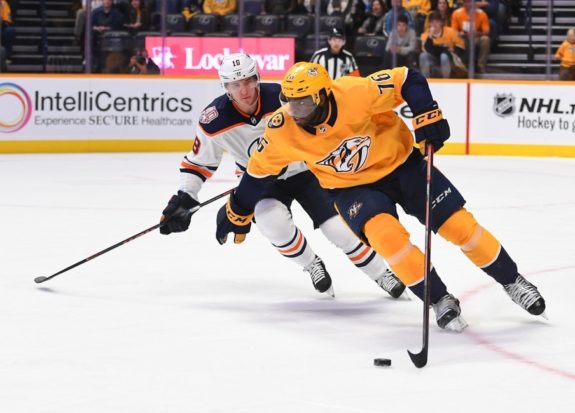
Among Predators defensemen, he had the second-highest possession exit percentage and the best carry-in against and passing plays allowed percentages. Additionally, he had the highest Corsi and shot attempts per-60 minutes. Unfortunately, that hasn’t stopped many Predators fans from wanting to see him traded this offseason, which, to an extent, has merit. He looks lazy at times in the defensive zone, committing borderline interference or stick infractions on the opposition rather than have good positioning.
Subban may not be the offensive threat that Josi is, nor is he as good of a one-on-one defender as Ekholm, but he is still the Predators’ best all-around blueliner. He had a down season, but one thing that can’t be denied is how well he played in the playoffs, posting one goal and two assists. However, that still doesn’t make up for how poor of a regular season he had.
Question(s): This one is pretty easy. Will he be in Nashville to start the 2019-20 season or will he be shipped out for forward help?
Grade: C | His season wasn’t as bad as many want to think it was, but it also wasn’t good. More is expected from a player with four 50-point seasons to his name and a Norris Trophy, and he didn’t deliver in 2018-19.
Dan Hamhuis
Veteran Dan Hamhuis can’t be graded on the same scale as the four listed above, simply because he plays a different role. When the Predators signed him as a free agent during the 2018 offseason, it was for him to play on the bottom pair in a defensive role. Any offense he contributed was an added bonus. So his five points, all assists, in 57 games may be the worst offensive season of his career, but it’s his defensive impact where he shined.
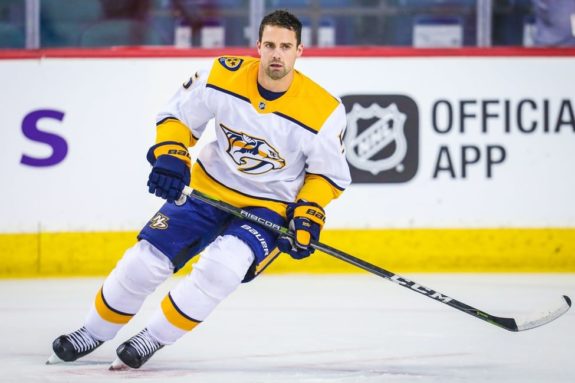
Among Predators defensemen with at least 100 five-on-five minutes in 2018-19, Hamhuis ranked first in shots against, expected goals against, and scoring chances against, all per-60 minutes. He took the most defensive zone starts of the position and was a mainstay on their penalty kill. What’s weird about his season is that he did almost nothing with the puck. He rarely entered the offensive zone or exited the defensive zone, and he also didn’t pass the puck often.
He did, however, greatly impact the team’s play without the puck in a positive way. At five-on-five, the opposition was a minus-seven percent threat to score with Hamhuis on the ice. Without him, and it rose to plus-two percent. On the penalty kill, the opposition was a minus-25 percent threat when he was deployed and a minus-12 percent when he wasn’t. But it was his impact on rookie Dante Fabbro where Hamhuis played his biggest role. Hamhuis’ presence as a steady, stay-at-home defenseman allowed Fabbro to play his game, meaning he didn’t have to worry about making mistakes. It helped Fabbro get comfortable with the NHL game, and it showed, especially in the playoffs.
Question(s): At 36, when does Hamhuis’ play begin dropping off? In such a defensive role, skating isn’t as big of an issue, but you never know. Also, if Fabbro moves into the top-four next season, who does Hamhuis play with?
Grade: B | Hamhuis did everything asked of him and played well in that role. He was a veteran partner for the Predators’ top defense prospect, which allowed for a smooth transition.
Matt Irwin
Matt Irwin and Yannick Weber both played sparingly. Irwin got into 44 games and looked decent in doing so. Prior to Fabbro turning pro, Irwin or Weber played on the third pair with Hamhuis, and earlier in the season when Hamhuis and Subban were hurt, they were partners on the bottom pair. Irwin actually had the team’s third-lowest expected goals against rate for defensemen, which is surprising.
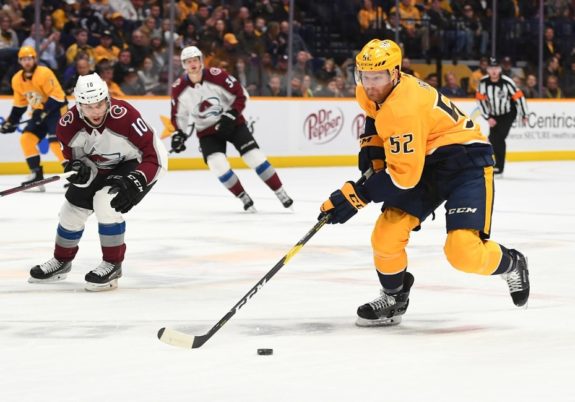
Question(s): What is his role next season?
Grade: C | He was the team’s seventh defenseman for much of the season and played that role well.
Yannick Weber
Weber was essentially the right-shot version of Irwin. In 62 games he had two goals and six assists and only averaged 11:55 of ice time per game. Like Irwin, Weber played with Hamhuis on the bottom pair before Fabbro turned pro and also formed the third pair during Subban and Hamhuis’ injuries. The metrics actually show that Weber was a pretty strong defenseman this season and he improved his partners, which surprised me. He remains a seventh defenseman, but he’s a pretty reliable one.
Question(s): What is his role next season?
Grade: C | Like Irwin, Weber played his role well. He wasn’t flashy, but he also didn’t hurt the team too often.
Dante Fabbro
Fabbro entered the 2018-19 season as the Predators’ top defense prospect. He was going into his junior season at Boston University and there was no guarantee he was going to sign when his college season concluded. So when it was announced that he was forgoing his senior season, it was met with approval.

He played in four regular-season games after turning pro, making his debut on March 30. He scored his first point, a goal, in his fourth game on a great play in which he moved in deep in the offensive zone. He never looked out of place and played his game well. And then came the postseason. He played in all six games, topping out with 15:04 of ice time in Game 4. He even recorded an assist in Game 3. For a 20-year-old defensemen with less than 10 games of NHL experience, Fabbro fit in well and proved the Predators right in their decision to never trade him.
Question(s): Will he get into a top-four as soon as 2019-20? And what does his ceiling look like?
Grade: A+ | It wasn’t entirely certain that he’d turn pro, and he did. That in and of itself is worthy of a high grade because it meant they weren’t going to lose him to free agency after his senior season. But then factor in that he played great, and it was all positives.
Overall Thoughts on Predators Defense
The Predators have one of the league’s best defense corps and their top-four produces a lot of the team’s offense. When everything clicks, that works great. However, in 2018-19, their defense didn’t live up to expectations. Of the top-four, Josi was the only one who didn’t disappoint. Hamhuis played great on the third pair, but Ekholm, Ellis, and Subban were all somewhat of a letdown.
The best of the position was Fabbro, whose emergence brightens the team’s future. With the team in need of more scoring, there’s a strong chance 2018-19 was the final season of their elite top-four. When 2019-20 rolls around, the Predators’ blue line could look much different.